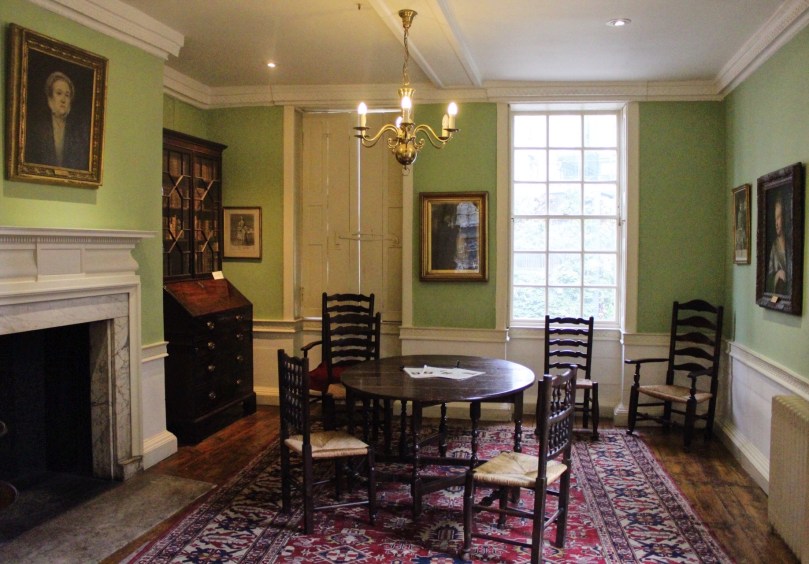My first toy was a dictionary, so it only made sense for me to pay a visit to Dr. Samuel Johnson’s home-turned-museum in London. Dr. Johnson, publisher of the first printed English dictionary, was born into his fate, as I learned on the candlelit tour, since he has been born in a bookstore. Wordies, linguists, and English teachers will all be mused, and inspired, by the quips and quotes from Dr. Johnson, all on display throughout the house. Pictures of important friends and family hang beside replicas of the first English dictionary, while the museum staff enthusiastically shares intimate details of Dr. Johnson’s life.

As the tour continued, I learned about Elizabeth Carter, a pioneering woman who studied the Classics back when women weren’t exposed to such scandalous texts. Lauded by Dr. Johnson as a good cook, and even better conversationalist, Elizabeth Carter helped him edit texts, while also expanding his social circles. The other memorable highlight was the story of Francis Barber, Dr. Johnson’s manservant and friend, who eventually became Dr. Johnson’s heir. As a man who loved a debate, Dr. Johnson strongly opposed slavery and bequeathed much of his small estate to someone who came into Dr. Johnson’s life shortly after his wife had passed.
Listening to our guide reveal more details of Dr. Johnson’s remarkable life, I was inspired by this man who seemed to be a pioneer in his own right. Flipping through his detailed dictionary, I thought about the enjoyment I used to get from mine, coercing childhood friends to play word games, after which they eventually tired, saying it reminded them of school.


I certainly didn’t think I’d be eating tacos in London. But lucky for my strong sense of smell, I was led along the cobbled streets of Soho by the trace of hickory smoke to an underground haven called Temper. Unbeknownst to those walking by, it has a modest front, and you’d never know that this culinary gem lies below. Looking around, trying to figure out where the luscious smell was coming from, I saw blocks of firewood through the glass, my first clue that I had found the source.

Do not come to Temper if you are a vegetarian or vegan. The sight of lamb shanks, beef loins, and a pig’s head roasting over crackling fires might deter you. It only lured me in further. I took a seat at the bar-the perfect spot to watch the Temper team make fresh tortillas, prepare cuts of meat, and toss eggplant onto the coals. When my plate finally came, it was hard to decide where to start. The fresh burrata drizzled with lime and jalapeno oil, or the soft cuts of pork gently set atop fire-grilled tortillas? Life should always be filled with such decisions! With portions small enough to sample a few options, I began my fireside feast.

In the era of smartphones, it seems as though there’s a social media channel to suit everyone’s fancy. I love Instagram, so it was only natural that I pay a visit to Saatchi Gallery, “the world’s number one museum on social media” as they say on their site. And rightly so. With tastefully, yet provocatively, curated exhibits, Saatchi Gallery is a must-see while you’re in London – whether or not you have a smartphone.

I planned to see the opening of Saatchi Gallery’s SALON featuring Tsuyoshi Maekawa’s paintings, and was pleasantly surprised. A longtime fan of Maekawa’s work, I learned a bit more about his art and the Gutai Art Association, Japan’s post-war avant-garde art collective. The word gutai means “concrete”, and was an intentional choice by the collective’s founder “to express the idea that art constitutes the embodied, material manifestation of human spiritual freedom.”
Walking among the rest of Maekawa’s work, and Saatchi Gallery, I thought about my own spiritual path, what “freedom” really means, and the profound and distinct impact that art has on all of us.
Leaving Saatchi Gallery, I enjoyed an uncharacteristically sunny day in London and walked up to the Victoria and Albert Museum. Friends who recommended I visit warned me that the museum was large, but I had no idea what to expect upon arriving. Holding over 2.3 million objects, I figured I should tackle only two exhibits and save the rest for my next trip to London.
A photography enthusiast, I caught the last days of The Camera Exposed, a small exhibit that featured black and white photography, with each photograph capturing the camera, either in the hands of the photographer, or angled to attempt antiquated selfies. Studying each image, some dating as far back as the 1850s, I was reminded of my days in the dark room back in college.

My last stop at this immense place was the Lockwood Kipling exhibit. Up until early April, this exhibit details some British history, not only of the V&A Museum and its beginnings as the South Kensington Museum, but Kipling’s contributions to the arts and crafts in the Punjab region of British India.
An illustrator, designer, curator, and teacher, Kipling, along his wife Alice, made much of his life, and artistic contributions, in India. Intricate watercolors from artisans in Calcutta are displayed next to Kipling’s earthenware plates that depict these artisans, each piece telling a different story. As I stepped out of the exhibit in the expansive halls filled with art from around the world, I thought of the quote hung on the wall at Dr. Johnson’s home, “When a man is tired of London, he is tired of life; for there is in London all that life can afford”. I definitely wasn’t tired – just on to the next part of my journey.




